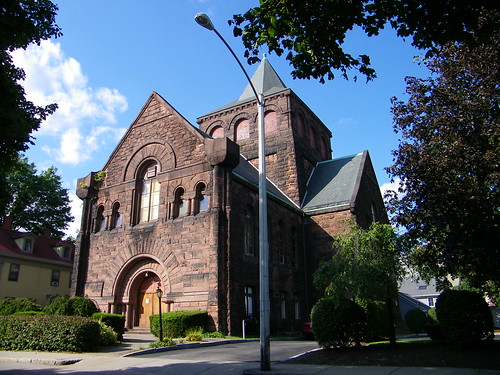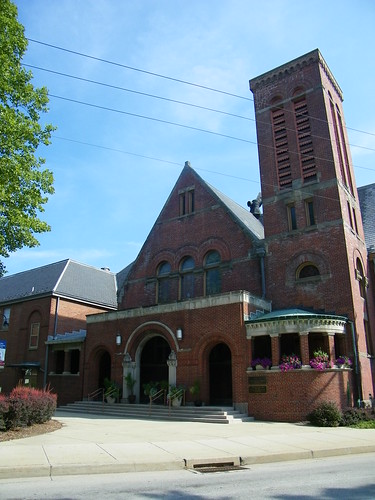
Photo Credit Donna Winton
The structure that thrust Henry Hobson Richardson into national prominence was Trinity Church, Boston; It spawned many North American churches with substantial central lanterns. Given this and his earlier work on churches, it is surprising to note that he completed only two more churches before his death in 1886.

One was a somewhat ungainly reformulation of Trinity for a Baptist congregation in Newton, MA. (It survives as a worship space shared by more than a half dozen congregations). There was apparently an intermediate lantern church design between Trinity and Immanuel Baptist, Newton (1884). Richardson proposed it to Emmanuel Episcopal Church in Allegheny City, now Pittsburgh's North Side. The building committe rejected the design, as the estimated cost exceeded by multiples the amount of their budget.

Richardson's next (and accepted) effort for Emmanuel Episcopal was a graceful yet spare brick box, with ornament restricted to subtle brick patterning and diaperwork (1885). It is much beloved locally and admired in wider architectural circles. Pittsburgh's James Van Trump found precedent for the form in English tithe barns. H. R. Hitchcock attempted to use it as support for his questionable claim that Richardson was proto-modern.
One might expect this elegantly simple (and relatively inexpensive) model to be emulated repeatedly. I thought I found such an example in Emory United Methodist Church, barely five miles as the crow flies from Emmanuel Episcopal in the city's East Liberty Section. Despite its form, composition and detail, the architects, Pittsburgh's MacLachlan, Cornelius & Filoni, tell me they addressed the church's wants and needs in the early 1970s without reference to the famous cross-town neighbor.

I was able to spot a clear influence of Richardson's gable facade in Latrobe, PA, thirty-five miles as a (more energetic) crow flies, from Emmanuel Episcopal.

Completed in 1892, Latrobe Presbyterian was designed by Pittsburgh's William Kauffman. Here, the gable proportions, triplet windows, slit windows as well as brick and stone details are clear echoes of Richardson's composition. And, in this case, Mr. Kauffman is in no position to refute my assumption.

Are there other churches whose form and composition (the locals fondly call it the bake-oven church) can be traced to Richardson's gem, Emmanuel Episcopal?

4 comments:
Comment
Good question Tim. I'll keep my eye out. In the meantime, here is Cram on the matter:
"In Trinity Church, Boston, there is much to admire, much of which we can stand in awe; but, beautiful as it is, it would have been better for the architecture of this country if it had never come into existence. From it have sprung nine tenths of the monstrosities that desolate the landscape, and add a new horror to our towns and cities. Only a giant can handle Romanesque, - and Richardson was a giant. His imitators were dwarfs, an din their hands the materials the master wielded with vast and wonderful power became the very millstones that drag them down in the sea of contempt."
I wonder how he really feels about it though.
By the way, that was The Gothic Quest, p. 194 in the freebie edition.
http://www.archive.org/details/gothicquest00cram
Thanks, Matt. I love those free downloads, but they end up costing me money: I always have to find my own hard copy.
There is a related question. What were the first examples of Richardsonian Romanesque lantern churches after Trinity? I have not yet found any built before HHR's Immanuel Baptist in Newton. There were a ton after that ugly duckling. I have found some Gothic Revival lanterns by William Halsey Wood, who was surprisingly prolific for one who, like HHR, died so young.
Post a Comment